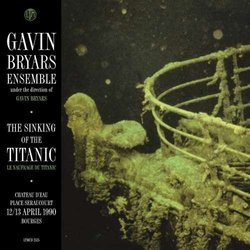DEATH'S COLD WAVE I WILL NOT FLEE
Kerry Leimer | Makawao, Hawaii United States | 07/25/2009
(5 out of 5 stars)
"Eno's Obscure label offered the first recording of "The Sinking of the Titanic" -- a shorter version than performed here -- and there have been many performances and recordings since. Now an even forty years on from its initial sketch, the piece has proven itself to be uniquely adaptive, a living work highly responsive to new influences in technology, instrumentation and interpretation. But for a number of reasons this rendition remains my favorite.
While music that cleaves to representational concepts usually ends up ossified and dated, Bryars hits on a few more convincing connections than the typical sort of "fawns represented by cor anglais" romances. That a hymn was played while the ship sank, that the radio operators were transmitting code, all provide distinctly authentic content for the work. Taking into account the acoustical properties of water and, in this instance performing the work in an abandoned three-story water tower, makes an even more immediate connection between source and execution, in an ideal context. But mostly, the sombre character of the work, slower here and undramatically elegiac, set in this particular environment with its acoustical appropriateness to the subject combined with a longer, more subtle entropic arc, make the Bourges performance a genuine reference point for the work.
Together with another recent Crepuscule reissue -- "Hommages" -- these two recorded works encapsulate many of Bryars' earliest and most lasting preoccupations: the use of found material (here, snippets of the Hymn "Autumn" among the many sources quoted on "Hommages" and fully developed with "Jesus' Blood..." and later still in exploring Medieval Lauds with his "O Mi Lasso" suite) integration with specific acoustical spaces ( the recent "Chambre d'écoute") and "automatic" solutions, Bryars persists in systematically delving into every implication of his aesthetic, with remarkable result. And in many ways, though the interpretations may have no practical end, it all starts with this piece."

